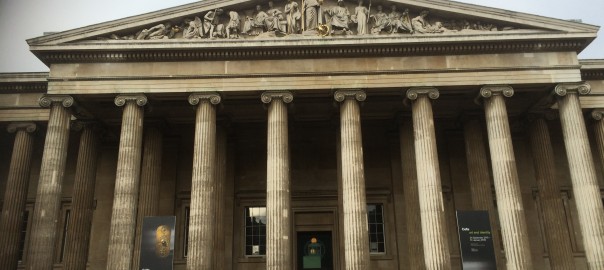 The overwhelming setting of the British Museum played host to this year’s Museums Computer Group “Museums and the Web” Conference, and as usual, a big turnout from museums institutions all over the UK came, bursting with ideas and enthusiasm. The theme (“Bridging Gaps and Making Connections”) was intended to encourage thought about identifying creative spaces between physical museums collections and digital developments, where such spaces are perhaps too big, and how they can be exploited. As usual, there was far too much interesting content to cover fully in a blogpost- everything was thought-provoking, but I’ve picked out a few highlights.
The overwhelming setting of the British Museum played host to this year’s Museums Computer Group “Museums and the Web” Conference, and as usual, a big turnout from museums institutions all over the UK came, bursting with ideas and enthusiasm. The theme (“Bridging Gaps and Making Connections”) was intended to encourage thought about identifying creative spaces between physical museums collections and digital developments, where such spaces are perhaps too big, and how they can be exploited. As usual, there was far too much interesting content to cover fully in a blogpost- everything was thought-provoking, but I’ve picked out a few highlights.
Two projects highlighted collaboration between museums, which can be creatively explosive, and immediately improve engagement. Russell Dornan at The Wellcome Institute showed us #MuseumInstaSwap, where museums paired off and filled their social media feeds with the other museum’s content. Raphael Chanay at MuseoMix, meanwhile, arguably took this a step further by getting multiple institutions to bring their objects to a neutral location (Iron Bridge in Shropshire, Derby Silk Mill), and forming teams to build creative prototypes out of them across the digital and physical spaces. Could our museums collections be exploited in similar ways? Who could we partner up with?
I like to think that our “digital and physical” teams in L&UC collaborate very effectively. Keynote speaker John Coburn from TWAM (Tyne and Wear Archives and Museums) spoke of the importance of this intra-institution collaboration. You will (almost) never find a project that is run entirely from within the digital or physical sphere (Fiona Talbott from the HLF confirmed this- 510 of 512 recent bids had digital outputs relating to physical content), and the ability of the digital area and the content providers to communicate and work together is key. One very good example of this was the Tributaries app, built with sound artists, the history team, archives and so on, to put together an immersive audio experience of lost Tyneside voices from World War I. He also spoke of their TNT (Try New Things) initiative (also creatively explosive!) where staff sign up to do innovation with the collections, effectively in their spare time. With the Innovation Fund encouraging creativity, how do we work this into our daily lives? Can we? If not, how do we incentivise people to do it outwith their spare time? One of the gloomier observations of the day was that, with austerity, there is less and less money in the sector, which is likely to get worse after next month’s spending review. This austerity can breed creativity, though, and it’s good for digital, because people need to ‘work smarter’.
Another really interesting project is going on at the Tate, where they are combining their content with the Khan Academy learning platform. Rebecca Sinker and colleagues showed us how content can be levered and resurrected through a series of video tutorials around the content (be they archival, technical, biographical etc). Pushing the collaborative textual content from the comments area on the tutorials through to social media allows further engagement and new perspectives on the museum objects. Speaking personally, I have had little exposure to our VLE, but I’m quite sure that developing an interface between it and our collections sites could be highly beneficial.
That’s all the tip of the iceberg, though, so take a look at the programme link at the top to find out about lots of other interesting projects.
Outside of the lecture theatre, I had some really interesting conversations with people who have exactly the same problems as ourselves: building image management workflows, incorporating technological enhancements to content-driven websites, and thinking about beacon technology (the sponsors, Beacontent, deserver top marks for the name at least). Additionally, a tour of The Samsung Digital Discovery Centre– where state of the art technology meets British Museum content to improve the experience for children, teenagers, and families- was highly informative.
Scott Renton, Digital Developer
